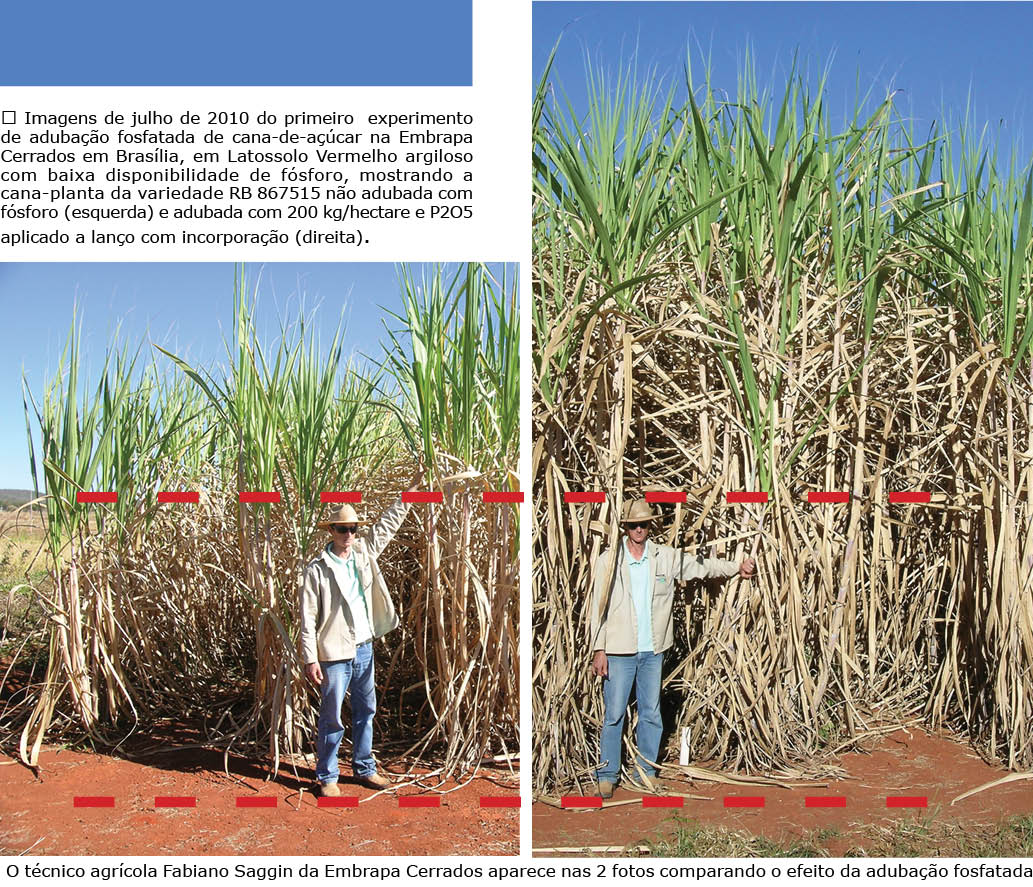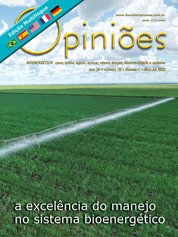Thomaz Adolpho Rein e João de Deus Gomes dos Santos Jr
Pesquisadores da Embrapa Cerrados
OpAA76
Cana-de-açúcar na região do Cerrado brasileiro manejo da adubação fosfatada
Antecedentes
O desenvolvimento de recomendações para a correção da fertilidade dos solos do Cerrado, em bases econômicas e fundamentadas nas suas análises químicas e físicas, foi uma das principais missões da Embrapa Cerrados, unidade da Empresa Brasileira de Pesquisa Agropecuária criada em 1975. A acidez dos solos e a deficiência generalizada de nutrientes, principalmente o fósforo (P), eram os principais fatores limitantes à produção agrícola na região. As doses econômicas de P para culturas anuais em áreas de abertura de cerrado mostravam-se superiores às recomendações de adubação adotadas até então.
Com base na experimentação em solos com diferentes teores de argila, foram geradas, no início da década de 1980, as primeiras recomendações de adubação fosfatada corretiva (fosfatagem). Doses variando de aproximadamente 100 a 250 kg/ha de P2O5, na forma de fontes solúveis, aplicadas em área total e incorporadas ao solo no primeiro ano e complementadas com doses anuais na linha de semeadura, mostraram-se necessárias.
Com a ampla adoção do plantio direto na região a partir de meados da década de 1990, novas estratégias de adubação fosfatada passaram a ser estudadas na Embrapa Cerrados por meio de experimentos de longa duração. Os resultados mostraram a viabilidade da adubação fosfatada anual de manutenção a lanço em pré-plantio da soja e do milho em substituição à adubação na linha de semeadura e em solos com teores adequados (corrigidos) de P, prática hoje adotada em mais da metade da área cultivada com essas culturas no Cerrado, agilizando as operações de plantio.
Com a ampla adoção do plantio direto na região a partir de meados da década de 1990, novas estratégias de adubação fosfatada passaram a ser estudadas na Embrapa Cerrados por meio de experimentos de longa duração. Os resultados mostraram a viabilidade da adubação fosfatada anual de manutenção a lanço em pré-plantio da soja e do milho em substituição à adubação na linha de semeadura e em solos com teores adequados (corrigidos) de P, prática hoje adotada em mais da metade da área cultivada com essas culturas no Cerrado, agilizando as operações de plantio.

Cana-de-açúcar
Com a grande expansão do setor sucroalcooleiro no Brasil Central nas duas últimas décadas, a Embrapa Cerrados iniciou em 2008 um amplo programa de pesquisas em cana-de-açúcar. O manejo da adubação fosfatada foi um dos principais assuntos estudados. Partiu-se do conhecimento gerado na unidade para culturas anuais, bem como na revisão dos resultados publicados de experimentos de adubação fosfatada da cana-de-açúcar realizados por diferentes instituições.
Os primeiros experimentos foram instalados a partir de 2009 nas usinas Goiasa, Anicuns, Jalles Machado e Vale do Verdão no estado de Goiás, na Destilaria Veredas e na Usina WD em Minas Gerais, e na Usina Pedro Afonso em Tocantins, além de experimentos em Brasília. Atualmente, a experimentação e outros estudos estão sendo realizados nas usinas do grupo São Martinho em São Paulo e Goiás, e na Embrapa Cerrados. Os resultados experimentais confirmaram as respostas econômicas à adubação fosfatada corretiva, complementando a adubação no sulco de plantio em solos com baixa disponibilidade de P, com efeito residual ao longo de cinco cortes e ganhos de produtividade de colmos por corte, variando de aproximadamente 5 a 20 t/ha.
Esses ganhos são explicados não apenas pela dose adicional de P na adubação corretiva, mas também pela alta eficiência de uso pela cultura do P incorporado em área total. Mostrou-se a possibilidade de substituição da adubação fosfatada no sulco de plantio, aplicando-se toda a dose de P a lanço com incorporação.
Os resultados experimentais revelaram produtividades superiores ou semelhantes com o superfosfato em doses elevadas (>150 kg/ha de P2O5) aplicado a lanço com incorporação comparada às mesmas doses no sulco de plantio. Em experimentos nas usinas Goiasa e Jalles Machado, verificou-se também alta resposta à adubação fosfatada de soqueira em solos com baixa disponibilidade de P, adubados no sulco de plantio, mas sem adubação corretiva.
Nessas condições, foram observados ganhos anuais de produtividade de colmos de até aproximadamente 20 t/ha, com doses anuais de 40 kg/ha de P2O5 aplicado sobre o palhiço nas linhas da cultura. A presença de abundantes raízes superficiais na interface solo-palhiço explica a alta eficiência de uso pela cana-de-açúcar do P solúvel aplicado superficialmente.
Ganhos de produtividade com a adubação fosfatada de soqueira, menos pronunciados, foram também observados na presença da adubação corretiva. Surpreendente grande aumento de produtividade com a adubação fosfatada de soqueira foi observado em experimento em andamento na Embrapa Cerrados, em solo com muito baixa disponibilidade de P, adubado no plantio com 200 kg/ha de P2O5 no fundo do sulco.
A aplicação de mais 200 kg/ha de P2O5 na forma de superfosfato triplo em faixas após o terceiro corte proporcionou ganho de produtividade de aproximadamente 40 t/ha de colmos já no quarto corte, com aumentos observados em todos os componentes do rendimento (número de colmos por metro, comprimento e espessura dos colmos).
A rápida e pronunciada resposta da cultura à essa adubação mostra a viabilidade da “fosfatagem de soqueira” como uma oportunidade de recuperação da produtividade do canavial quando a disponibilidade de P é o fator limitante, com expectativa de efeito residual na reforma subsequente.
Fontes alternativas também foram estudadas. A torta de filtro avaliada em experimentos nas usinas Jalles Machado e Goiasa e na Embrapa Cerrados mostrou-se equivalente ao superfosfato quando aplicados nas mesmas doses de P2O5 total.
Fosfato natural importado de alta reatividade (alta solubilidade em ácido cítrico) mostrou-se equivalente ao superfosfato quando aplicado a lanço com incorporação em solo com pH (em água) abaixo de 6,0, sendo esse desempenho superior ao verificado em experimentos anteriores no primeiro ano com culturas anuais.
Significativa perda de eficiência foi verificada para o mesmo fosfato em experimento na Destilaria Veredas em solo com pH superior a 6,5. Já em aplicação localizada, no fundo do sulco de plantio, a eficiência do fosfato foi baixa em ambos os experimentos.
O efeito negativo da aplicação concentrada explica também a baixa eficiência como fonte de P de um fertilizante organomineral granulado a base de torta de filtro e fosfato natural de alta reatividade, avaliado em experimento na usina Jalles Machado. Fosfatos naturais brasileiros classificados como reativos e outras fontes alternativas de P estão sendo avaliados na Embrapa Cerrados.
Estudos de amostragem de solos canavieiros estão em andamento nas usinas do Grupo São Martinho, e tem como objetivos:
a) definir o número mínimo de subamostras necessárias para compor a amostra enviada ao laboratório;
b) conhecer o efeito da posição amostral em relação à linha da cultura sobre os atributos de fertilidade em diferentes profundidades.
Dos principais atributos, o P e o potássio são os que apresentam as maiores variabilidades, mesmo na escala de pequenas áreas na amostragem em malha, requerendo-se maior número de subamostras do que em sido adotado pelas usinas em geral para a caracterização da disponibilidade destes nutrientes.
A pesquisa agrícola é um trabalho contínuo, em que muitas recomendações requerem atualizações em função da evolução dos sistemas de cultivo.
Recente publicação com recomendações de adubação fosfatada da cana-de-açúcar no Cerrado contemplando o sistema tradicional de cultivo, o cultivo irrigado e o sistema plantio direto na reforma do canavial pode ser acessada na página da Embrapa Cerrados:






